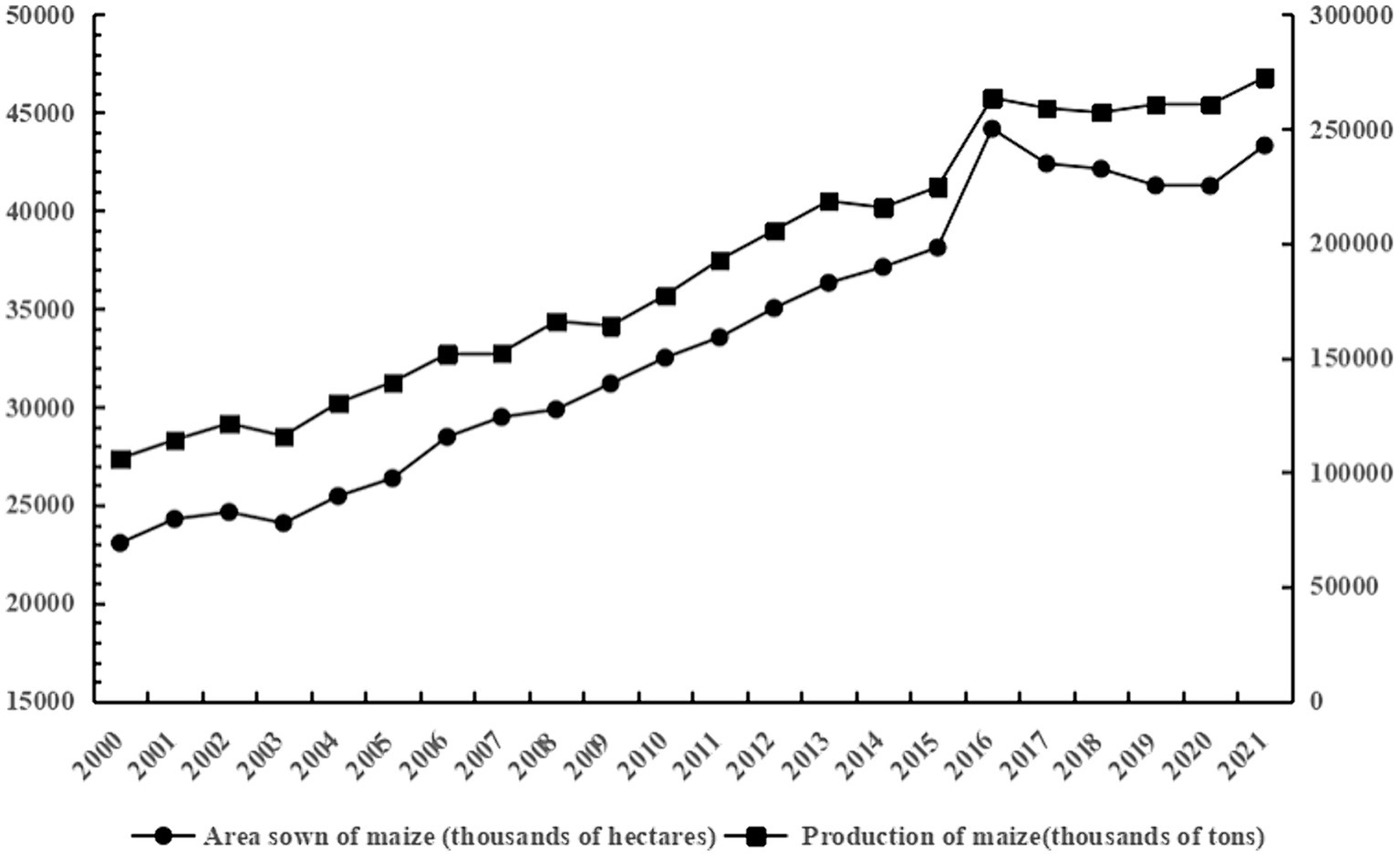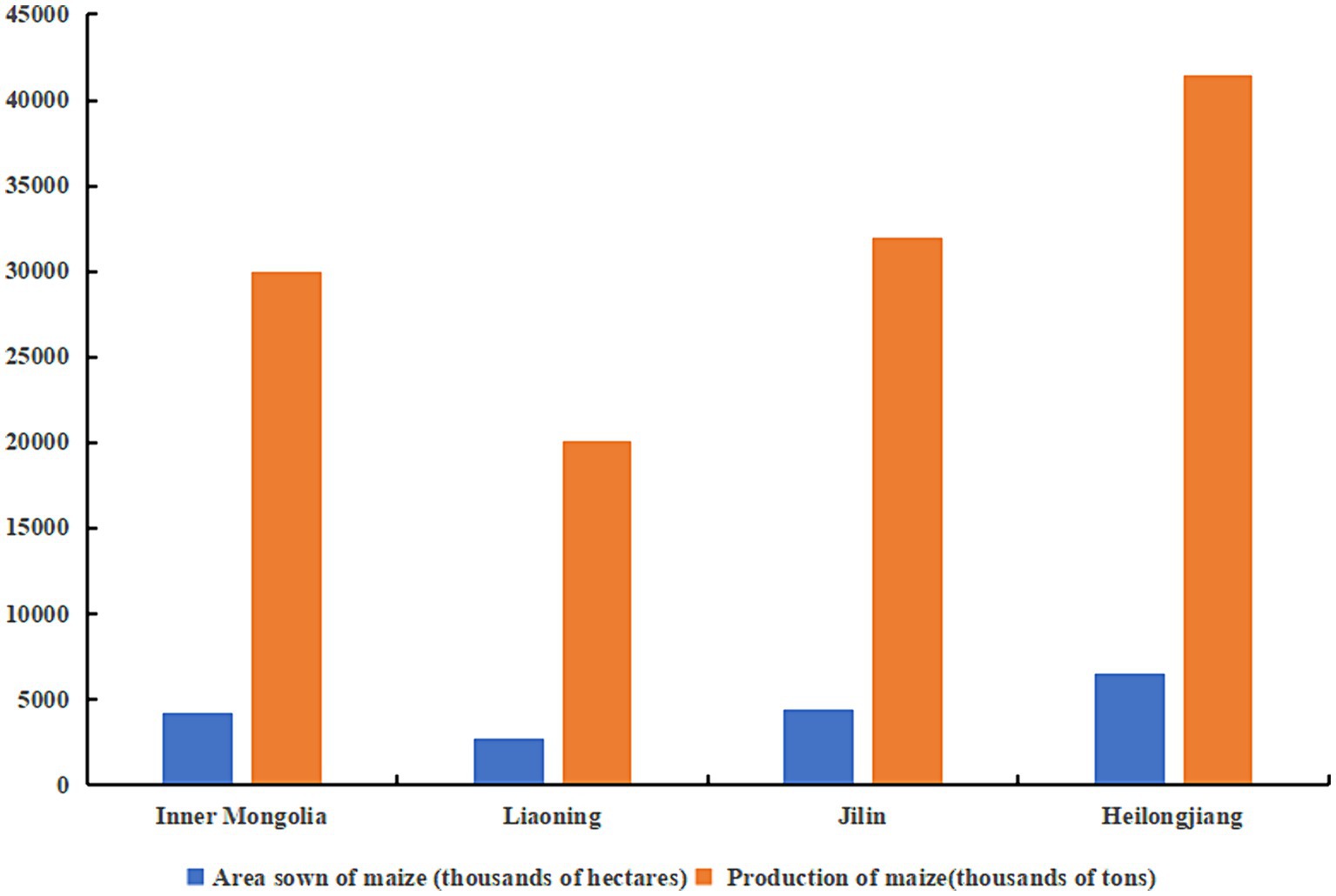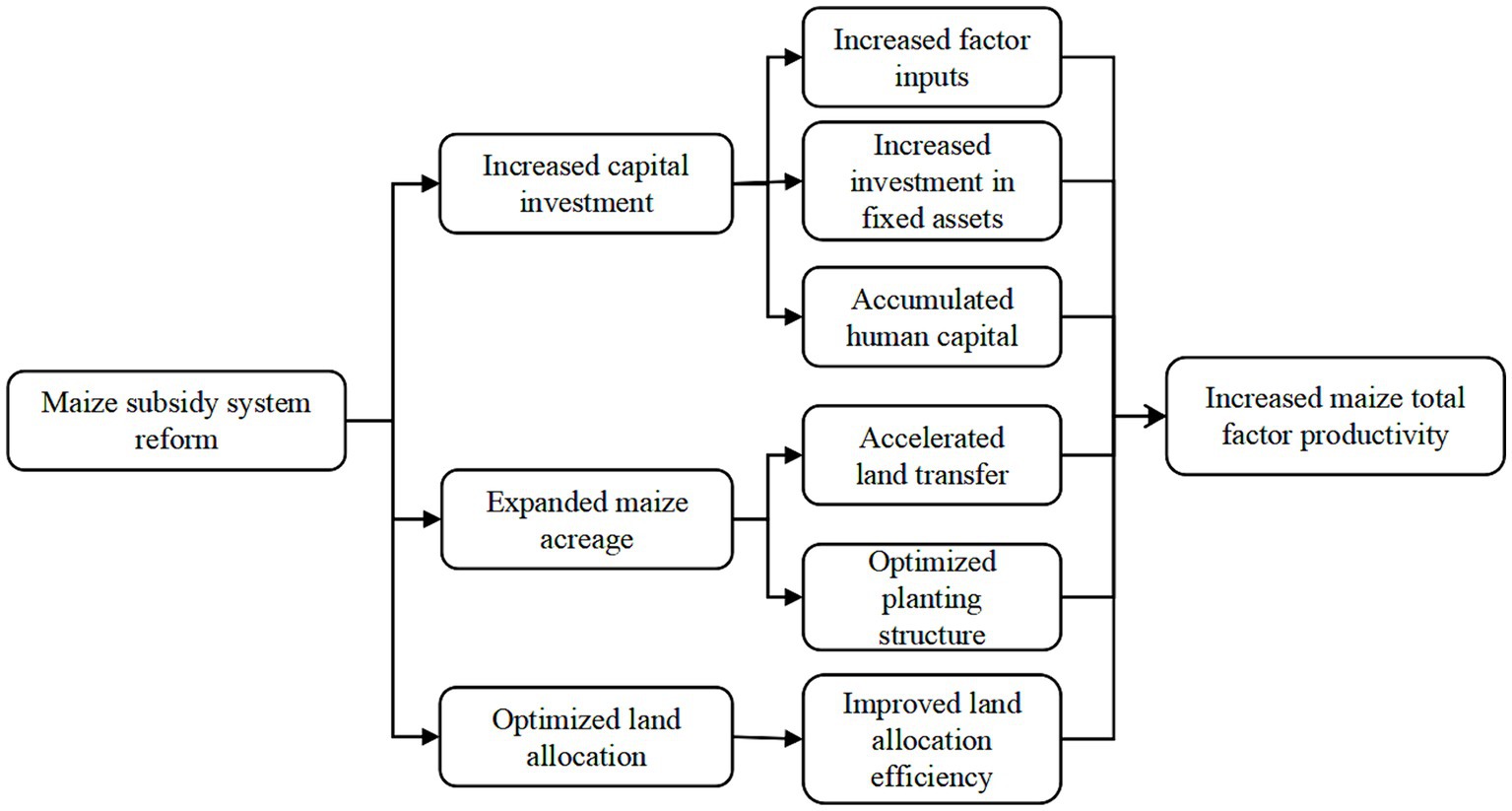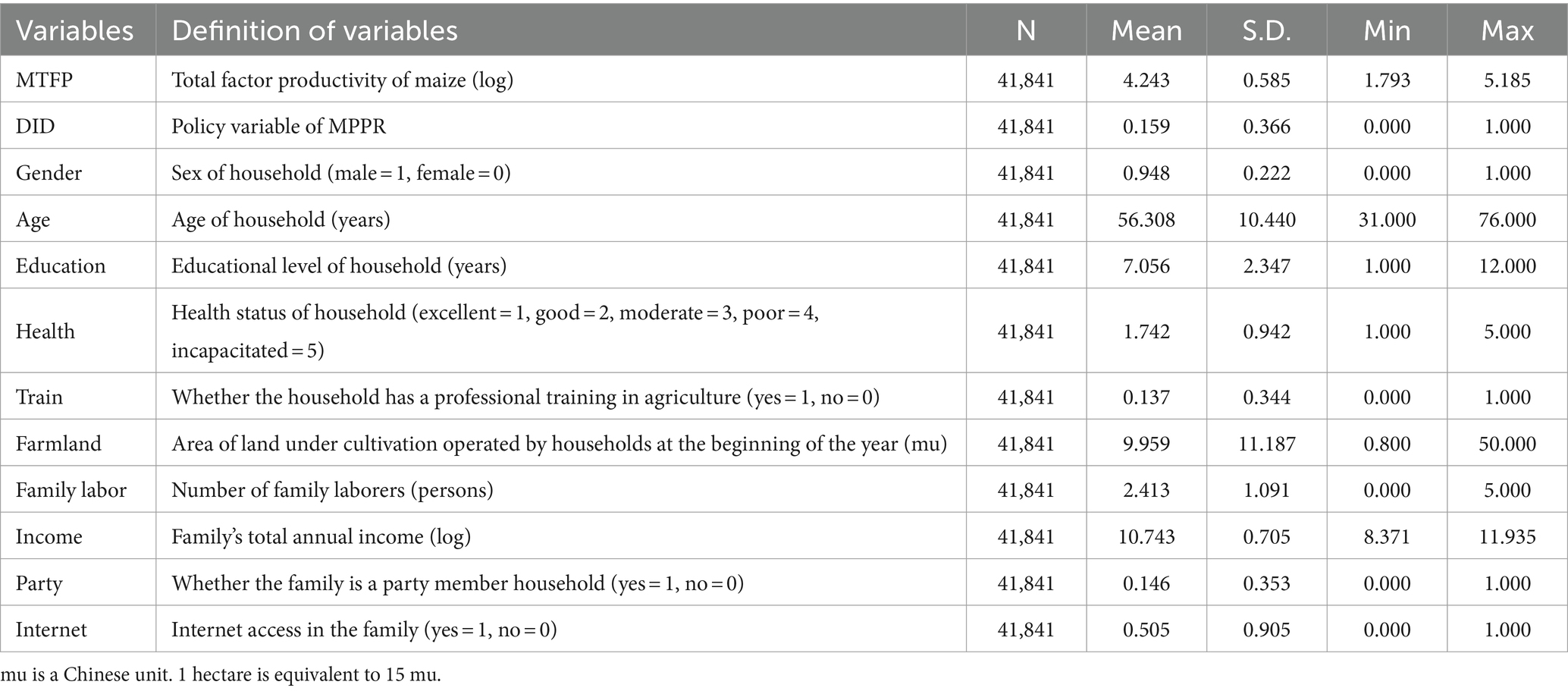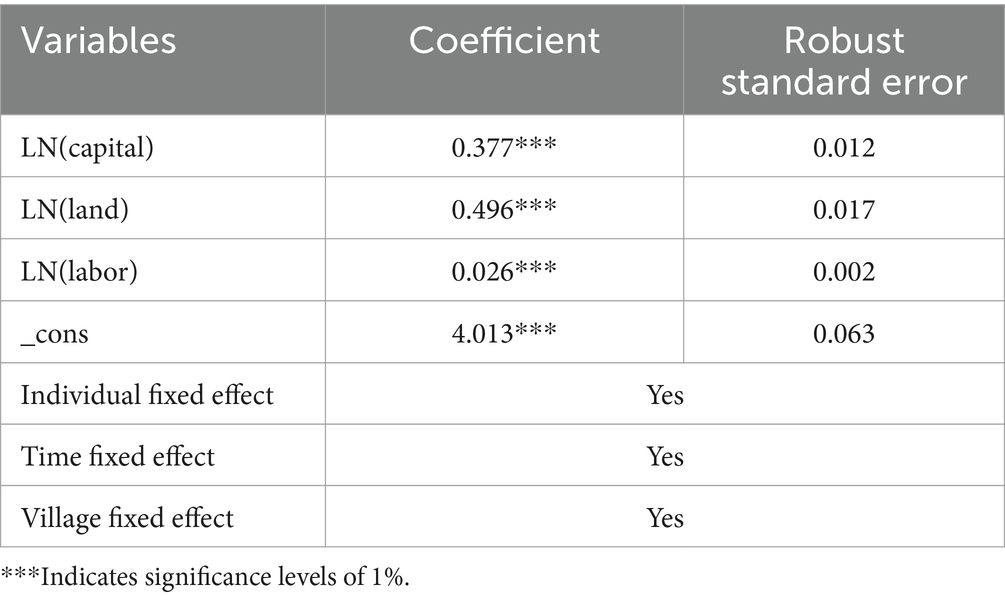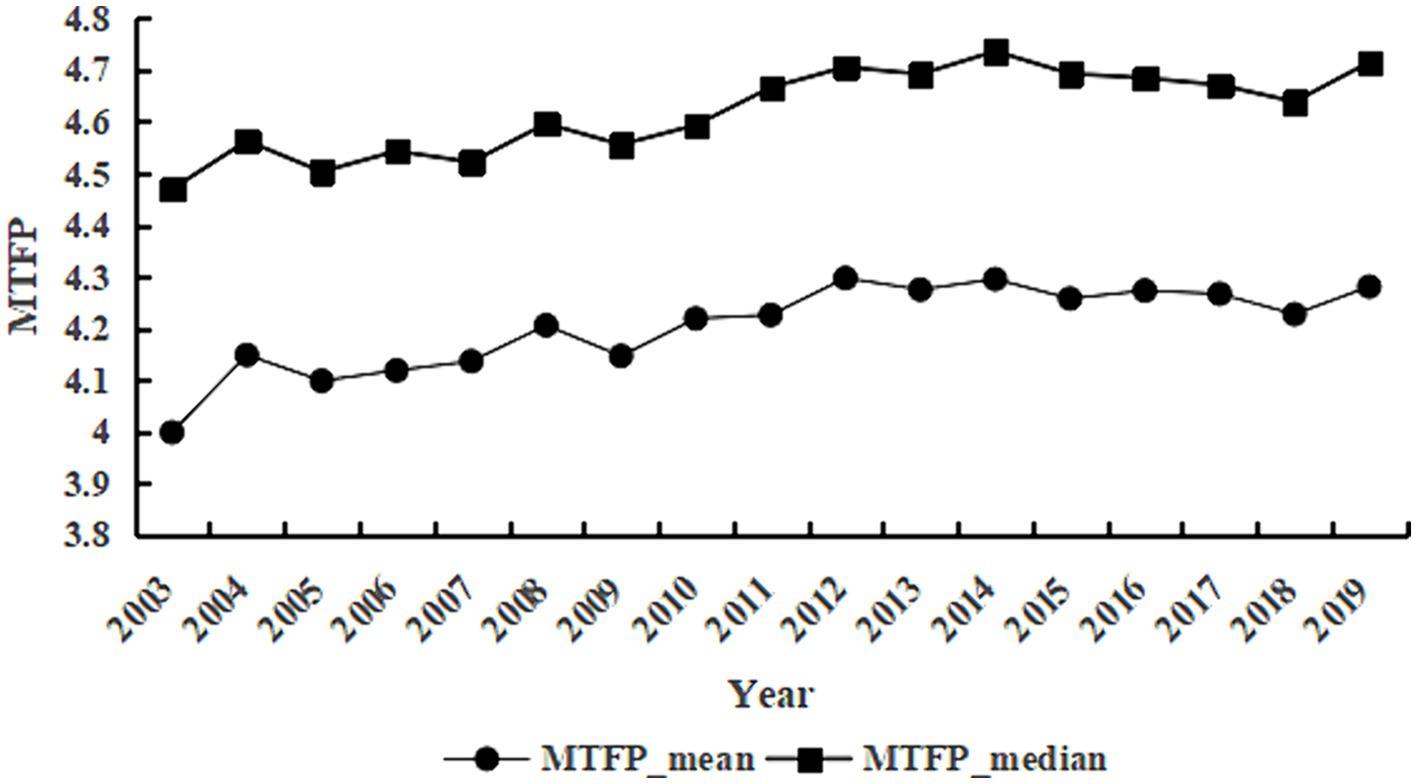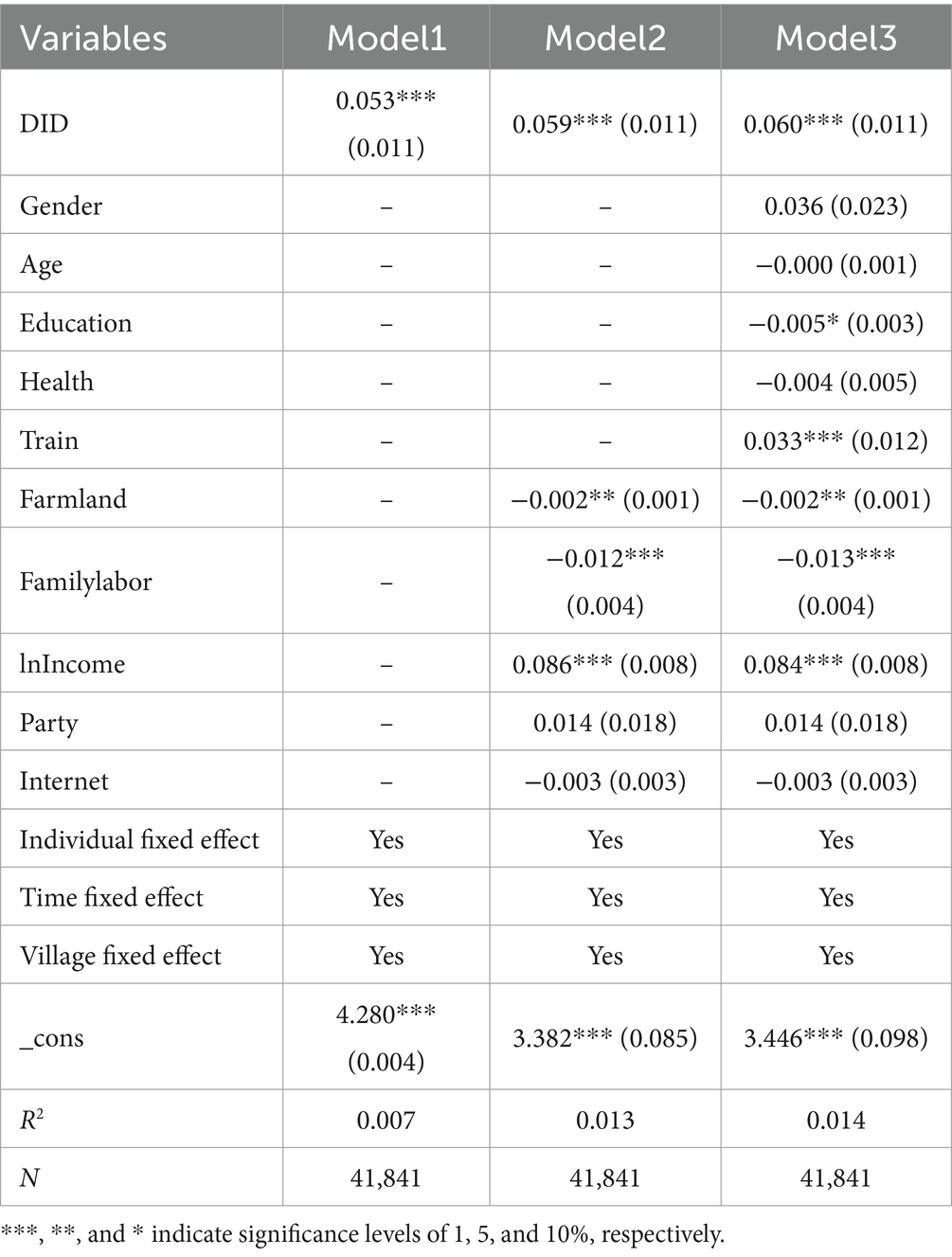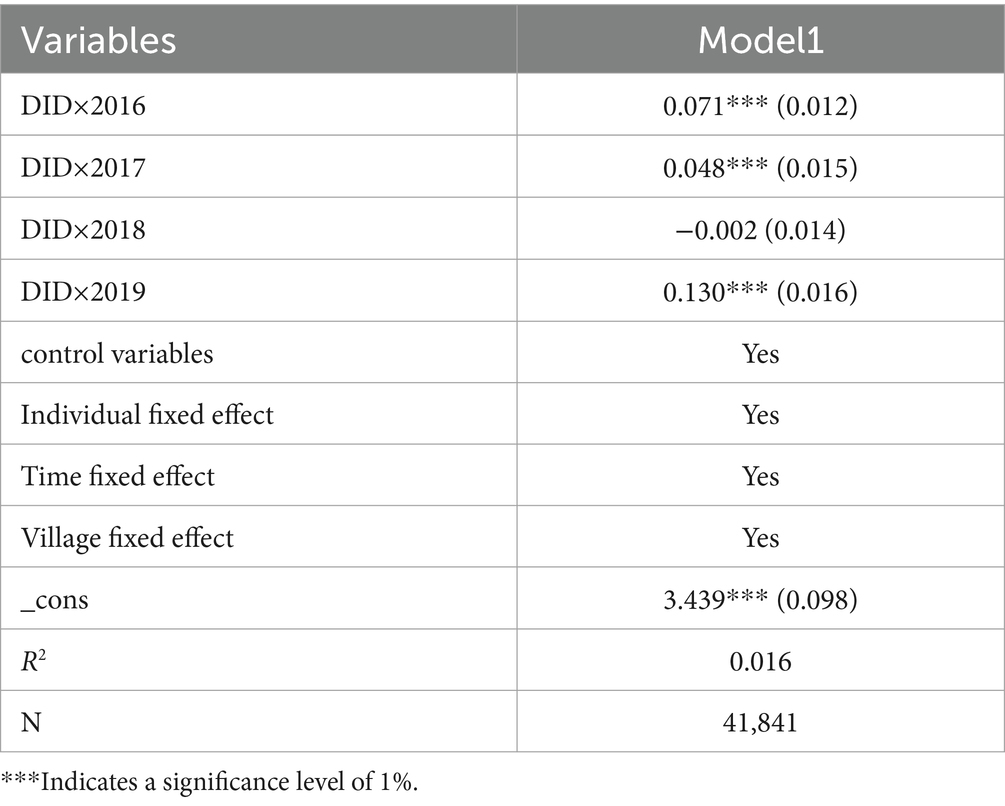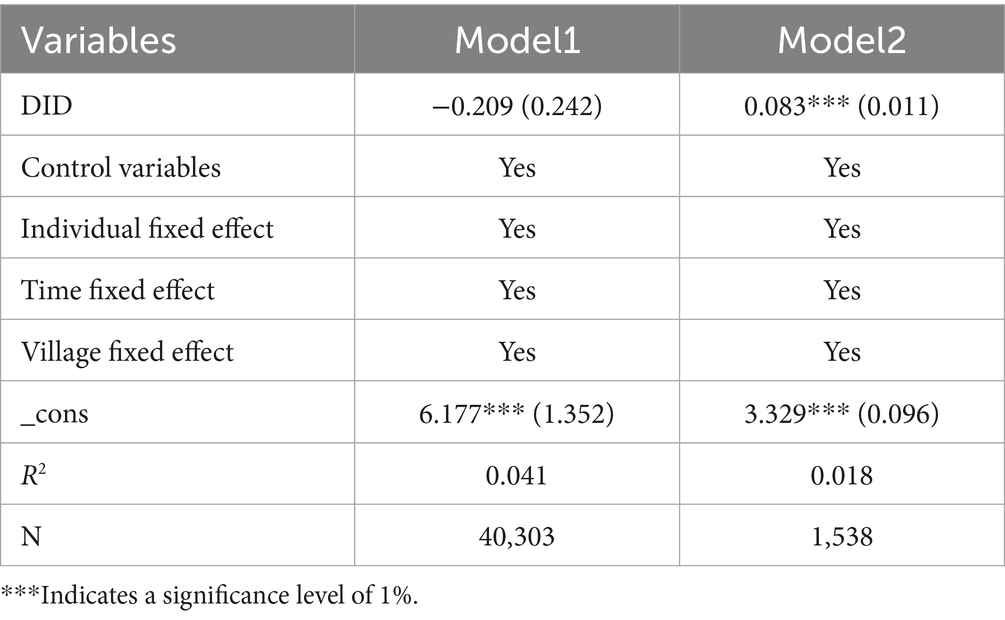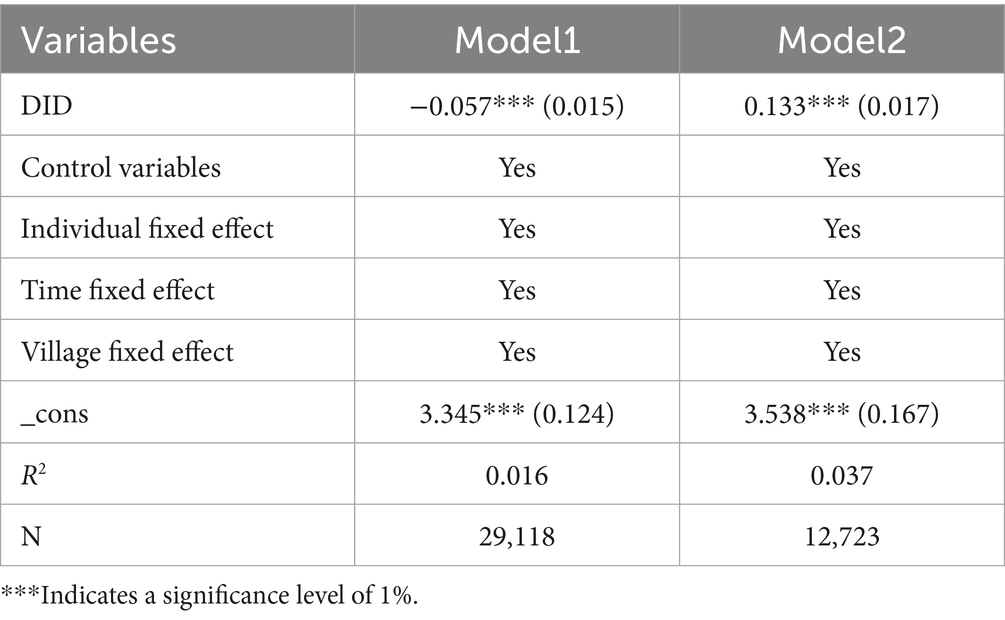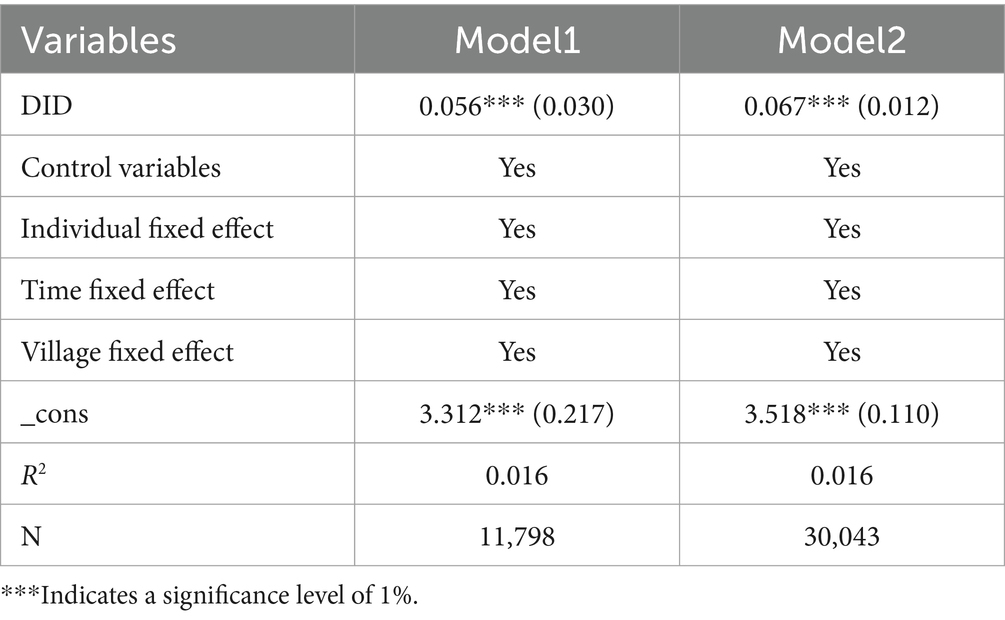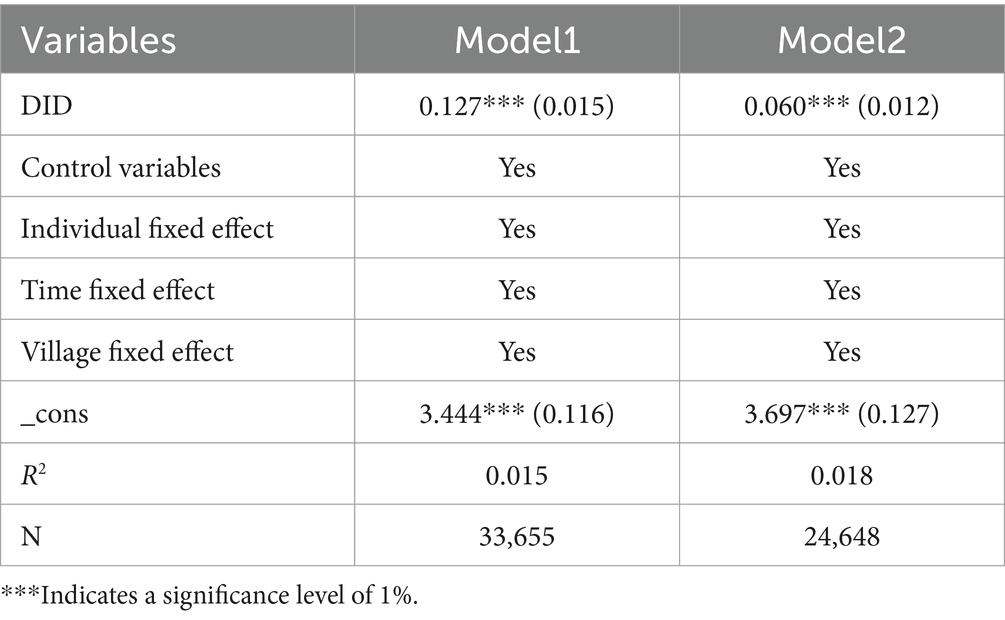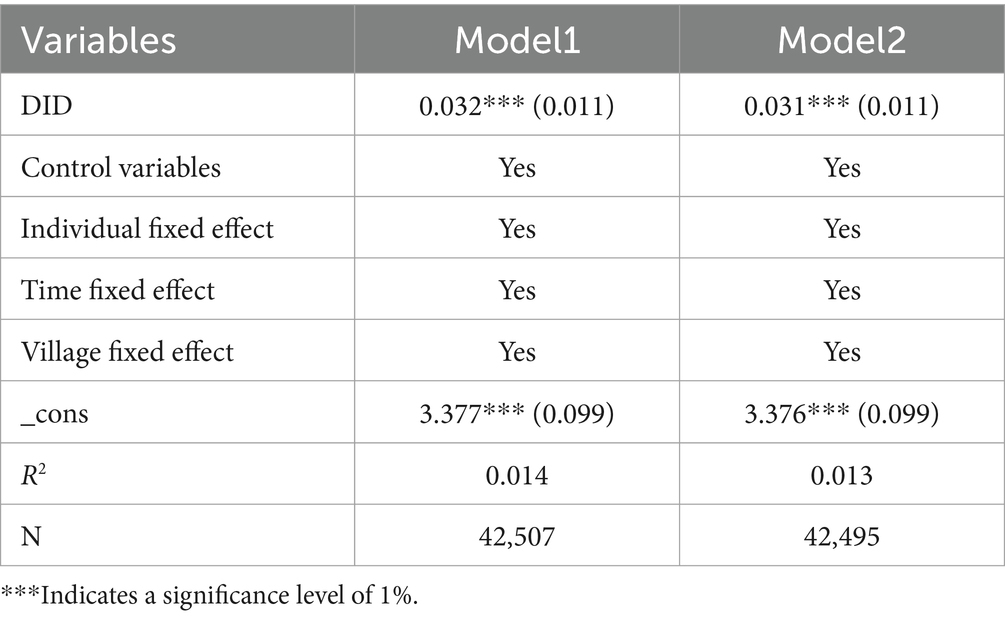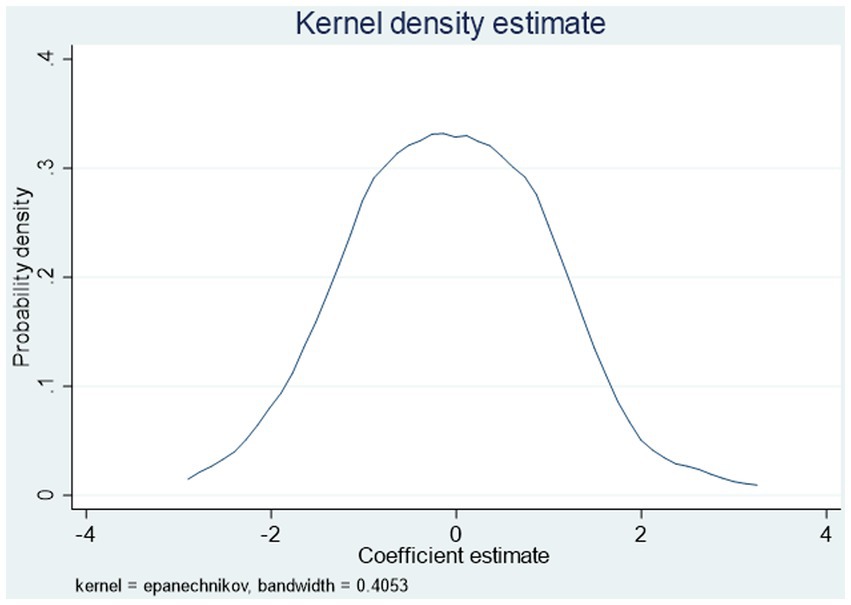- 1School of Economics and Management, Jiangxi Agricultural University, Economic and Technological Development Zone, Nanchang, China
- 2School of Tourism Management, Wuhan Business University, Wuhan Economic and Technological Development Zone, Wuhan, China
- 3School of Economics and Management, Yunnan Agricultural University, Kunming, China
- 4College of Economics and Management, Huazhong Agricultural University, Wuhan, China
Introduction: China is the largest producer, consumer, and trader of grain. Changes in China’s agricultural policies will affect global food trade and thus impact food security. In this paper, we use China’s maize subsidy system reform (MSSR) as a quasi-natural experiment to investigate the impact of market-oriented reforms in price support policy on the productivity of grain.
Methods: We use official Chinese government panel data on farm households and a PSM-DID model to overcome the endogeneity problem of policy change.
Results and discussion: The empirical results show that MSSR can increase maize productivity. The MSSR is divided into two phases: eliminating the maize purchase price and implementing maize producer subsidies. The policy effect of eliminating the purchase price exceeds the implementation of producer subsidies. Further analysis reveals that for farmers with a larger scale of cultivation, higher level of specialization, and higher degree of part-time employment, the MSSR enhances their productivity more significantly. In the high quartile, the MSSR reduces farmers’ productivity. In the low quartile, the MSSR raises farmers’ productivity, suggesting that the MSSR reduces the productivity differences among farmers. The results of our study suggest that market-based reform of price subsidies is an effective institutional arrangement to mitigate resource mismatch and increase food productivity, and point to the need to continue to improve the MSSR, explore diversified maize producer subsidy policies, and take into account the impact of other subsidies on farmers’ maize production behavior.
1 Introduction
Increasing grain productivity is essential for promoting sustainable agricultural development and reducing rural poverty (Ma et al., 2018; Zheng et al., 2021). However, in developing countries like China, grain productivity improvement has historically been challenged by various factors, such as pests and diseases, poor management, and extreme weather (Kumar et al., 2018; Zhang et al., 2020; Blekking et al., 2021; Sebhatu et al., 2021). In China, like other developing countries such as Nigeria, Ghana, India, and Pakistan, governments often intervene in production through agricultural subsidy policies to help improve farm performance (Jayne and Rashid, 2013; Shahzad et al., 2021; Baig et al., 2023). Agricultural subsidy policies usually include two types, namely direct agricultural subsidies based on inputs or land or outputs and agricultural price support policies (e.g., minimum prices and government procurement). Among these agricultural subsidy policies, agricultural price support policies are the most important and are usually implemented in developing or developed countries (Lin and Huang, 2021). Governments incentivize grain production by intervening in the grain market to guarantee food security in the country.
Since 2004, China has implemented grain purchase policies to increase farmers’ incentives to grow grain. Among them, the maize purchase policy implemented in 2008 is the core initiative of China’s grain price support policy (Gale, 2013; Hejazi and Marchant, 2017). Implementing the policy not only guaranteed the income of maize farmers but also induced farmers’ incentives to grow grain to a large extent (Liu and He, 2018; Li and Lin, 2022; Zheng et al., 2023). However, implementing this purchase policy has distorted the operation of the maize market and led to distorted resource allocation (Li et al., 2020; Ye et al., 2023a). Recent studies have shown that the relative inefficiency of agriculture in poor countries may be due to distortions in resource allocation resulting from low marketization (Lagakos and Waugh, 2013; Adamopoulos and Restuccia, 2014; Chari et al., 2021; Adamopoulos et al., 2022). Therefore, the Chinese government piloted MSSR in four northeastern provinces (Inner Mongolia, Jilin, Liaoning, and Heilongjiang) in 2016, which provided a quasi-natural experiment for our study. The policy objectives of MSSR are to adjust the cropping structure, optimize resource allocation, and increase maize productivity.
Theoretically, MSSR will promote resource allocation efficiency and improve grain cultivation structure, thus increasing farmers’ maize productivity. However, in reality, the actual policy effects are not yet known, limited by the degree of farmers’ understanding of and response to the policy and the efficiency of the policy implementation by each local government. Therefore, this paper empirically analyzes the impact, heterogeneity, and mechanism of MSSR on maize productivity using micro-data from fixed observation sites in rural areas across China’s Ministry of Agriculture Development. Our findings can provide new insights for optimizing MSSR and empirical lessons for market-oriented reforms of grain price support policies in developing countries.
There is extensive literature on the relationship between agricultural subsidy policies and productivity, but the findings are mixed. Scholars have come up with two different opinions. First, agricultural subsidies can reduce the productivity of farm households. Agricultural subsidies may reduce agricultural productivity by reducing farmers’ attitudes toward risk and affecting their motivation for agricultural production (Martin and Page, 1983; Serra et al., 2008). It has also been shown that the negative impact of subsidies on productivity may be due to the loss of allocative and technical efficiency due to distortions in the structure of production and the use of agricultural factors of production (Leibenstein, 1966; Alston and James, 2002; Rizov et al., 2013). Secondly, agricultural subsidies can increase the productivity of farm households. Subsidies can help farmers overcome financial constraints to increase investment or adopt more advanced technologies to improve their production capacity, thus promoting agricultural productivity (Zhu and Lansink, 2010; Yi et al., 2015). It has also been argued that the increase in agricultural productivity from subsidies only occurs in areas with imperfect market development. For example, in the case of imperfect insurance markets, subsidies may reduce risk and trigger farmers to invest in certain activities that are excessively risky when agricultural productivity increases as subsidies increase (Roche and McQuinn, 2004; Garrone et al., 2019).
Therefore, the overall objective of this paper is to analyze the impact of market-oriented reforms of price support policies on the total factor productivity of grain by using China’s MSSR as a pilot. At least two reasons justify an empirical study of this topic in China. First, given China’s large population, any change in agricultural policy could profoundly influence international grain trade and global food security. China’s newly implemented agricultural subsidy policy reforms may affect grain productivity and thus impact global food security. Second, China is a typical developing country exploring the reform of its agricultural support policies. Taking China’s agricultural subsidy policy reform practice as an example, it can provide experience for improving agricultural support policies in developing countries.
We contribute to the literature in the following three ways. First, we employ a unique micro panel dataset for empirical analysis. As far as we know, this is the first time we have used official Chinese government farm household research data to analyze the effects of the MSSR. This analysis is essential because the goal of MSSR in China is to promote sustainable grain development and food security. The productivity is a good indicator of the policy objective. Second, we adopt the PSM-DID model to overcome the endogeneity problem of policy reform, which can get more accurate parameter estimates. In this paper, based on the pilot character of MSSR, we use a combination of PSM and DID to mitigate endogeneity. Variables that do not vary over time and individually yet affect farmers’ total factor productivity in maize (e.g., factors such as light, rainfall, and temperature) can be eliminated by the DID model. PSM can be used to satisfy the parallel trend assumption through sample selection, which is an essential assumption for the validity of the DID model. Third, this paper can complement the current literature on agricultural subsidy policy reform and grain productivity. We not only study the short-term and long-term effects of MSSR but also investigate the heterogeneity of the impact of MSSR on maize productivity from four dimensions: land size, level of grain specialization, farmers’ part-time employment, and farmers’ maize productivity, and the results of the study can improve the precision of MSSR implementation.
The rest of this study is structured as follows. Section 2 provides policy background and theoretical analysis framework. Section 3 contains materials and methods. Section 4 presents the results and discussions. Section 5 includes the conclusions and policy recommendations.
2 Policy background and theoretical analysis framework
2.1 Maize production in China
China’s maize planting area has remained stable at over 600 million mu year-round, and production has been around 250 million tons year-round. These large production scales and yields give China a global leading position in the maize industry. China rivals world-renowned maize-producing regions such as the U.S. Maize Belt and the Ukrainian Maize Belt, which together constitute one of the largest maize-producing regions in the world. Maize is an important grain crop in China, which plays a vital role in guaranteeing China’s food security and serves as an essential feed source (He et al., 2020; Xin, 2022). After 2000, the sown area and total output of maize in China have risen (Figure 1). In 2000, the sown area of maize in China was only 23,056.1 thousand hectares, and by 2021, the sown area of maize in China will be 43,324.2 thousand hectares, with a growth rate of 87.91%. At the same time, China’s total maize production has risen from 106,000 kilotons in 2000 to 272,551 kilotons in 2021, a growth rate of 157.12%. It should be noted that the sown area and total production of maize began to decline after 2016 due to the MSSR in China.
Maize is mainly grown in 20 provinces in China, namely Hebei, Shanxi, Inner Mongolia, Liaoning, Jilin, Heilongjiang, Jiangsu, Anhui, Shandong, Henan, Hubei, Guangxi, Chongqing, Sichuan, Guizhou, Yunnan, Shaanxi, Gansu, Ningxia and Xinjiang. Inner Mongolia, Jilin, Liaoning, and Heilongjiang are the main maize-producing provinces with more favorable climatic conditions. These four provinces were selected by Chinese policy to pilot the reform of the maize storage system. In 2021, their planted area was 17,854.2 thousand hectares, accounting for 41.2% of the national total. Figure 2 shows the sown area and production of maize in these four provinces in 2021. Among them, Heilongjiang leads the way regarding maize sown area and total production.
2.2 Policy background of MSSR
Since 2004, China has conducted a series of explorations of the grain purchase system to increase farmers’ incentives to grow grain. Among them, the maize purchase policy is the core initiative of China’s grain price support. Affected by the financial crisis of 2008, maize prices in the international market dropped significantly, and domestic maize prices also faced downward pressure. The government initiated the maize purchase policy to smooth out the fluctuation of maize prices. Implementing the policy not only protects the income of maize farmers but also mobilizes farmers’ enthusiasm to grow grain to a large extent (Gale, 2013; Hejazi and Marchant, 2017). However, this market purchase has distorted the operation of the maize market, resulting in an imbalance between maize supply and demand (Gu et al., 2018). On the one hand, domestic maize is much higher than the international market price, and the import volume of maize surges yearly. On the other hand, the competitiveness of domestic maize has declined, resulting in a large amount of maize being converted into stockpiles, and the financial burden of national grain storage has increased (Gong et al., 2021).
The Chinese government decided to abolish the maize storage system in March 2016, fully liberalize the maize market, and adopt a new form of “market-based pricing and producer subsidies.” Maize prices are determined by market supply and demand, and all market players can trade freely according to market prices, and the state subsidizes producers. The policy reform shows that the government intervention is gradually weakened, the maize price mechanism is gradually formed, and the market will play a decisive role in the allocation of resources (Han et al., 2022). Based on guaranteeing that the income of maize farmers will not be affected too much, the government gradually adjusts the maize planting structure through the market mechanism and producer subsidies, thus improving the competitiveness of maize (Ye et al., 2022). In addition, unlike other staple grains such as wheat and rice, maize is used chiefly for deep processing such as feed and alcohol. The MSSR is mainly centered on “difficulty in selling grain” and “difficulty in exporting, “the state and the pilot district governments have introduced the support policy, credit guarantee fund for purchasing loans, and the new maize. The state and pilot zone governments have successively introduced support policies for purchasing new maize, credit guarantee funds for purchase loans, and free high-speed transportation of maize to support the MSSR.
2.3 Theoretical analytical framework
The study of Adamopoulos et al. (2022) shows that low agricultural productivity in developing countries mainly comes from small planting scale, low productive investment, and inefficient allocation of agricultural resources. To further explore the impact of MSSR on farmers’ maize productivity, this paper combines the existing research to construct the analytical framework of “institutional reform–planting scale/productive investment/land allocation efficiency—maize productivity.” The analytical framework is shown in Figure 3.
First, MSSR can increase farmers’ maize productivity by expanding the planting area. The scale of operation is an essential determinant of agricultural productivity. With increasing scale, farmers can adopt more advanced technology for production, thus increasing maize productivity (Coelli et al., 2003; Giang et al., 2019). Due to the specialized character of agricultural assets, MSSR can increase farmers’ maize planting area by expanding the planting area. Asset specialization refers to the difficulty of changing the use of certain assets that are locked in for a specific purpose during the production process. If they are used for other purposes, they may become less valuable or even worthless (Klein et al., 1978). In the pre-MSSR period, farmers’ average maize yield will be reduced, and some large-scale farmers are unable to withdraw from production due to the strong specialization of the input assets, so in order to maintain the income, they can only choose the production method of “many kinds of multi-profit” to carry out production. Therefore, the MSSR can increase maize productivity by adjusting the planting scale of farmers.
Secondly, MSSR can increase farmers’ maize productivity by increasing their productive investment. Increasing productive investment in agriculture can improve agricultural production conditions and thus increase agricultural productivity (Hu et al., 2023). On the one hand, MSSR can enhance the short-term investment of farm households. After the reform, farmers’ returns consisted of maize selling prices and producer subsidies. The market determines the price of maize and presents a significant price difference according to the quality of maize. Farmers will use organic fertilizers instead of chemical fertilizers, selected seeds, and other initiatives to improve the quality of maize to obtain more income. On the other hand, MSSR can increase farmers’ long-term investment. Farmers will increase long-term investment to improve soil fertility to obtain long-term profits. In addition, maize producer subsidies can increase maize productivity through human capital accumulation. After receiving subsidies, farmers can participate in technical training to accelerate human capital accumulation, thus increasing maize productivity (Li and Lin, 2022). Therefore, MSSR can increase maize productivity by increasing the productive investment of farmers.
Thirdly, MSSR can improve farmers’ maize productivity by optimizing land resource allocation. Improved resource allocation efficiency is important to enhance agricultural productivity (Yang et al., 2022). Land transfer is an essential means to improve agricultural resource allocation. Land rent is an important influence factor on land transfer rate, and when land rent is too high, land transfer will be hindered. It can be seen that the rent of land transfer will be affected by the fluctuation of maize price, and the MSSR can directly affect the maize price and, thus, the rent of land transfer. During the implementation of the maize purchase policy, the “government purchase” makes the land rent rise, and land transfer is hindered (Liu and Qin, 2019). After the MSSR, the price of maize began to fall, and the expected income of farmers decreased. At this time, the rent of land transfer also fell sharply, and the land transfer rate increased (Xu et al., 2021). Therefore, MSSR can improve the degree of land mismatch to increase the maize productivity of farmers. In summary, we found that MSSR can increase maize productivity by expanding the area of maize cultivation, increasing productive investment in maize, and optimizing the allocation of land resources.
3 Materials and methods
3.1 Data
The data used in this paper come from the National Rural Fixed Observation Points (NRFOP) of the Ministry of Agriculture and Rural Affairs of China, which is an official micro-research data of the Chinese government (Chari et al., 2021; Ge et al., 2023). This survey began in 1986 and is China’s largest farm household-level tracking research data (Chen, 2012). This data has several advantages: its large and wide sample size and survey scope, making it highly representative. Currently, the annual sample size of the survey is about 21,000 farm households, involving 360 villages and 31 provinces (cities and districts) across China. Then, the content of the survey is rich and exhaustive. The data includes many aspects such as land, household management, inputs of production materials, household consumption, and so on. In particular, the data are very detailed on the inputs and outputs of households in the production of different crops, including specific data on the inputs and outputs of food production of farm households in each region. Moreover, the quality of the data is high. The survey team used a bookkeeping method to collect data from farmers. Since the data is tracking data, almost all interviewed farmers are familiar with the research process, which is undoubtedly significant for improving data quality.
In the existing literature, Shen and Yao (2008) explored the sampling of the data and described the initial sampling rules for the data. At the beginning of the survey initiation for the NRFOP in 1986, the researcher adopted a combination of typical and random sampling to conduct the survey. In the first step, typical sampling was adopted to determine the research villages. The province was divided into three regions based on geographic stratification: plains, hills, and mountains. The counties in the province were divided into three types of counties: high, medium, and low levels based on income stratification. The representative counties were selected as the research regions. In the second step, villages were randomly selected in the above research area to conduct farm household interviews, and 50 to 120 households were randomly selected in each village for the research. Benjamin et al. (2005) and Wang et al. (2020) compared and analyzed the fixed observation point data with the census data from the National Bureau of Statistics and found that the two data were relatively consistent regarding agricultural production, household income, etc. Adopting rural fixed observation point data for this study is more reasonable. We processed samples with entry errors, coding errors, and missing data, excluding farmers not engaged in maize production. Due to different research purposes, we selected a sample of maize farmers from 2003 to 2019 when measuring maize productivity. In analyzing the impact of MSSR on farmers’ maize productivity, we used the sample of maize growers from 2014 to 2019 because the MSSR was piloted in 2016.
3.2 Variable definitions and descriptive statistics
3.2.1 Explained variables
Farmers’ maize productivity is explained variable in this paper. We uses maize total factor productivity (MTFP) to characterize maize productivity. The advantages of adopting TFP are as follows: firstly, TFP can comprehensively consider the utilization efficiency of factors, which is a more comprehensive indicator; secondly, TFP contains technological progress, technological efficiency, allocation efficiency, etc., which can reflect the quality of the development of the maize industry. Therefore, we select TFP as an explained variable for policy evaluation.
Measuring MTFP requires setting the form of the production function. Referring to the research results of Chari et al. (2021) and Adamopoulos et al. (2022), we set the following production function for parameter estimation:
In Equation (1), denotes the level of maize output of farmer i. K, L, and M represent the physical capital inputs, labor inputs, and land inputs in the maize production of farmers, respectively, and the calculation of the specific inputs and outputs will be described in detail later. , , and represent the elasticity coefficients of physical capital, labor, and land. We treat the left and right sides of Equation (1) in logarithmic terms and introduce village-level dummy variables to control for inter-village differences. Eventually, we obtain the following Equation (2):
We use a multidimensional fixed effects approach to mitigate the endogeneity problem in the estimation of agricultural production functions (Wang et al., 2020). First, land quality differences are an important cause of endogeneity, and we use the method of controlling for village-level fixed effects to eliminate possible land differences between different villages. Second, we use individual fixed effects for differential elimination for individual resource essentials that do not vary over time. Finally, for omitted variables that do not vary with time characteristics, we use time-fixed effects to control for them. After parameter estimation, the MTFP of farmers can be calculated using the following Equation (3):
3.2.2 Core explanatory variables
The core explanatory variables in this paper are the policy variables of the MSSR.The policy effect variable of MSSR consists of the interaction of the time dummy variable and the regional dummy variable of MSSR implementation, and the size of the coefficient characterizes the degree of MSSR’s impact on maize productivity.
3.2.3 Control variables
Referring to existing studies (Wu et al., 2005; Li et al., 2010; Gao et al., 2017), this paper controls for other influencing factors affecting maize productivity. They are as follows: (1) Sex of household (Gender), male is 1, female is 0; (2) Age of household (Age), expressed as the age of the head of the respondent’s household in weeks; (3) Educational level of household (Education), expressed as the number of years of education received by the head of the household; (4) Health status of household (Health), 1 to 5 are excellent, good, medium, poor, and incapable of labor, respectively; (5) Whether the household has a professional training in agriculture (Train), assigned a value of 1 when the respondent has participated in vocational training, and 0 vice versa; (6) Area of land under cultivation operated by households at the beginning of the year (Farmland), the area of cultivated land owned by the household at the beginning of the year; (7) Number of family laborers (Family labor); (8) Family’s total annual income (Income), is the sum of the household’s income in a year, which is taken as the natural logarithm in this paper; (9) Whether the family is a party member household (Party), assigned a value of 1 when the respondent’s household is a party member household, and vice versa; (10) Whether the household has access to the Internet (Internet), assigned a value of 1 when the household has access to information on the Internet, and 0 otherwise. It should be noted that this paper deflates the data for the study variables involving prices, all of which are converted to constant price values with 2014 as the base period. Table 1 shows the descriptive statistics of the main variables.
3.3 Methods
The MSSR started in 2016 and was piloted in Liaoning, Jilin, Heilongjiang, and Inner Mongolia, which provided a quasi-natural experiment for this study. However, development economists almost universally recognize the endogeneity of policy change (Acemoglu et al., 2001). The traditional DID model presupposes a parallel trend between the experimental and control groups before the policy shock; otherwise, it would not be able to exclude the interference of other factors on the policy effect. However, the pilot of the MSSR may not be a random event, which would not satisfy the parallel trend assumption and thus lead to biased estimates of policy effects. This paper draws on the PSM-DID model proposed by Heckman et al. (1998) to study the effect of MSSR on farmers’ maize productivity.
The estimation of the PSM-DID model is divided into two stages. The first is the PSM estimation. We follow the year-by-year matching method to find the control and experimental groups. We explicitly use the Logit model to estimate the propensity score and K-nearest neighbor matching to select the matching samples. The matching model is Equation (4):
Where P denotes the probability that a farmer participates in the MSSR, treat denotes whether the farmer participates in the MSSR. Participation is assigned a value of 1, and non-participation is assigned a value of 0. L denotes the Logit regression model. X denotes the covariate used for PSM. After matching, 41,841 samples are obtained in this paper, including 10,737 experimental and 31,104 control group samples. The second step is DID estimation. In this paper, the following model expressed as Equation (5) is constructed to analyze the impact of MSSR on farmers’ maize productivity:
Where i represents the region and t represents the year. MTFP represents the total factor productivity of maize. DID represent the policy variables of MSSR, X represents the control variables, and represent year-fixed effects and individual fixed effects, respectively, represents the classical randomized disturbance term, and α and β represent the parameters to be estimated. The control variables in this paper contain two main categories: one for household head characteristics that affect maize productivity and the other for household characteristics that affect maize productivity.
4 Results and discussion
4.1 Measurement results of MTFP in China
In this paper, we use the NRFOP farm household panel data to estimate the MTFP of households. Table 2 shows the estimation results of the Cobb–Douglas production function by applying the growth accounting method. The elasticities of physical capital, land, and labor in the maize production function are 0.377, 0.496, and 0.026, respectively, which are highly consistent with the characteristics of resource endowment for maize production in China. Land is the most rare element in maize production, capital plays an equally important role, and only labor is affluent (Li et al., 2010). The sum of the three coefficients is 0.899, indicating that maize production is diminishing returns to scale, which is consistent with the findings of Chari et al. (2021).
After measuring the elasticity of each input factor, we calculate the MTFP of farm households in China from 2003 to 2019 using Equation (3). This paper adopts two methods, the simple average and the median, to calculate the MTFP of farm households in all the years. The measurement results are shown in Figure 4. We can get the following several conclusions. First, MTFP as a whole shows a steady upward trend, which is consistent with the study of Lou (2022). The difference is that this paper measures MTFP from the macro level while we calculate MTFP from the micro farmer level. From the mean calculation, MTFP increased from 3.998 in 2003 to 4.281 in 2019, with a growth rate of 7.079%. Secondly, in the short term, there was a decrease in MTFP in some specific years, such as 2004, 2008, and 2017.
4.2 PSM-DID regression results
This part mainly analyzes the average treatment effect of MSSR on farmers’ maize productivity. The regression results are shown in Table 3. Model 1 represents the results without controlling any variables, Model 2 represents the results after controlling for farm household characteristics, and Model 3 represents the results after controlling for all control variables.
The results of Model 3 show that MSSR increases maize productivity by 6.0% on average. The impact of MSSR on farmers’ maize productivity may come from two aspects: first, MSSR reduces the area of maize planted in non-dominant zones, improves the degree of mismatch of resources, and thus improves maize productivity. Most of the reduction of maize in these areas was in non-dominant areas. Second, after the MSSR, maize subsidies with noticeable differences will drive the concentration of maize production to the advantageous areas, thus promoting the scale of maize production and giving play to comparative advantages (Liu and Qin, 2019; Di et al., 2023).
The effect of control variables on the maize productivity of farmers can be obtained from Model 3 in Table 3. First, Education shows a negative relationship with maize productivity, which is consistent with the findings of Gao et al. (2017). Education is an important means of human capital investment, so education can increase agricultural productivity. However, as the level of rural education increases, the probability that farm households may go out to work rises, accelerating the transfer of agricultural labor and thus reducing agricultural productivity. Second, Train significantly increases maize productivity, which is basically in line with the study of Li et al. (2010). Farmers can understand the latest national agricultural policies and regulations by participating in agricultural vocational education, learning cutting-edge agricultural production and management technology, and increasing maize productivity. Again, there is a negative relationship between Farmland and maize productivity. The studies of Gautam and Ahmed (2019), Julien et al. (2019) also showed a negative relationship between farmland size and agricultural productivity. Compared to large-scale households, smallholders have the advantage of intensive farming, and their combined utilization of land, machinery, and other factors is more efficient, resulting in higher maize productivity. At the same time, small farmers can significantly resist natural and market risks due to the diversity of planting structures and the difficulty of planting structure adjustment, thus gaining advantages. Family labor and maize productivity are negatively correlated. Chinese agriculture is in small-scale operation, and in the process of mechanization promotion, maize production often does not need much labor, so the relationship between the number of labor and maize productivity is negative. Finally, Income significantly increases maize productivity, which is consistent with the findings of Ye et al. (2023a). As Income increases, farmers will increase investment in maize, which will promote technology adoption and thus increase maize productivity. In addition, an increase in income will alleviate the financial constraints of agricultural production, thus promoting agricultural production (Yi et al., 2015).
4.3 Dynamic effects of MSSR
The empirical results above obtained the average effect of MSSR on maize productivity, but it is difficult to reveal the dynamic effect of MSSR. Given that the MSSR is divided into two phases, the first is eliminating the maize purchase price (the first year), and the second is the implementation of the maize producer subsidy (the second year and beyond). Therefore, analyzing the dynamic effects of the MSSR on farmers’ maize productivity has important policy implications. The estimation results are presented in Table 4.
From Model 1, the coefficients for the second to fourth years of MSSR implementation are 0.048, −0.002, and 0.130, with a mean value of 0.059, smaller than the estimated parameters for the first year of MSSR implementation. By comparing the coefficients, we can infer that eliminating maize purchase price enhances maize productivity more than implementing maize producer subsidy. Market-oriented reforms will effectively promote the allocation efficiency of resources, thus significantly increasing maize productivity. Market distortions can reduce factors’ production costs and promote technological progress (Chari et al., 2021). In addition, because China has just started implementing maize producer subsidies, there are problems such as untimely subsidy methods and insufficient disbursement amounts, which can also limit the improvement of maize productivity by producer subsidies. Therefore, continuously optimizing the maize producer subsidy and giving full play to its policy effectiveness is a future reform direction for China’s price support policy.
4.4 Heterogeneity analysis
To understand in which groups the MSSR policy did not have an effect, this paper conducts a series of heterogeneity analyses. In this paper, we analyze the heterogeneity based on different land sizes, levels of specialization in maize cultivation, the degree of part-time work of farmers, and the productivity of farmers.
4.4.1 Heterogeneity of maize planting area
Considering the different results of behavioral adjustment to MSSR by farmers of different sizes, there will be significant heterogeneity in the impact of MSSR on farmers’ maize productivity. This paper divides the maize planting size into small farmers (less than 50 mu) and large-scale households (greater than or equal to 50 mu), and group regression is performed. Model 1 in Table 5 shows the regression results for the small-farmer sample, and Model 2 shows the regression results for the large-scale household sample.
The results show that the larger the planting scale, the more significant the impact of MSSR on farmers’ maize productivity. The probable reason is that when the maize purchase policy was in place, maize production was mainly output-oriented, and large-scale farmers would spare no effort to increase maize production. This type of production, which relies on excessive land grabbing, can degrade soil quality, lead to pesticide residues such as herbicides and insecticides, and seriously affect maize productivity (Ma et al., 2023). Meanwhile, at the time of the implementation of the storage system, there was a significant expansion of maize planting areas by large-scale households, which adopted a rough management method, in addition to changes in the agricultural planting structure of frozen areas, drought-prone areas and areas with mixed agriculture and animal husbandry, which also tended to plant maize, resulting in low maize production efficiency (Di et al., 2023). The sown area of maize in agro-pastoral areas in pilot provinces increased from 1,364.63 thousand hectares in 2008 to 2,189.29 thousand hectares in 2015, with a growth rate as high as 60.4%. Implementing the maize purchase policy led to a tendency to plant maize in non-dominant areas. However, the shortage of soil and water resources and soil degradation caused the total maize production in non-dominant areas to decline in productivity, although it was rising. After the MSSR, large-scale farmers would adjust planting structures to use the land with low maize yields for other production, significantly increasing the maize productivity.
4.4.2 Heterogeneity in specialization level
Maize farmers with different levels of specialization will choose different adjustment strategies when facing the MSSR, leading to significant heterogeneity in policy effects. In this paper, we use the proportion of maize sown area to grain sown area to measure the degree of specialization, classify them into high and low specialization levels based on the median, and finally conduct group regression. Model 1 in Table 6 shows the regression results for the low specialization level sample and Model 2 for the high specialization level sample.
The results show that the higher the specialization level of farmers, the more significant the impact of MSSR on farmers’ maize productivity in all cases. A possible explanation is that for farmers with lower levels of maize specialization, the area and share of maize planted are lower, and the MSSR has a limited impact on their returns and does not change their planting decisions, so the MSSR does not have an impact on their maize productivity. For more specialized maize farmers, due to market price differentials, farmers tend to choose high-quality varieties or improve the soil to improve the quality of maize, thus significantly increasing their maize productivity (Ye et al., 2023b).
4.4.3 Heterogeneity of part-time employment
The degree of part-time employment in a farm household is also an essential factor influencing the effect of MSSR on maize productivity. This paper uses the proportion of household agricultural labor to total labor to measure the degree of part-time employment. The mean of the degree of part-time employment is used to determine the degree of high and low part-time employment, and the results are shown in Table 7. Model 1 shows the sample of low part-time farmers, and Model 2 shows the regression results of high part-time farmers.
The results show that the higher the degree of farmers’ part-time employment, the more obvious the improvement of farmers’ maize productivity by MSSR. Maize price is an important factor affecting the returns of maize cultivation, and the decrease in maize price caused by MSSR will lead to a decrease in farm households’ returns of cultivation, thus adjusting the farm households’ cultivation structure. After the MSSR, farmers’ returns cannot be guaranteed as before the introduction of the maize purchase policy. For farmers with a high proportion of part-time employment, household income often consists of non-agricultural income, with a relatively low proportion of agricultural income (Li and Lin, 2022). When faced with the MSSR, these farmers are more likely to abandon land that faces losses, such as land with low soil fertility, which is more likely to increase their average maize productivity.
4.4.4 Heterogeneity of maize productivity
This paper examines the impact of MSSR on farmers’ maize productivity at various quantile levels. We obtained the results shown in Table 8 using unconditional quantile regression analysis. Unconditional quantile regression is a widely used method in analyzing treatment effect variance (Agyire-Tettey et al., 2018; Ma et al., 2020; Ye et al., 2023c), as it does not depend on control variable fluctuations. Models 1–5 represent the regression outcomes at the 10th, 25th, 50th, 75th, and 90th quartiles. First, the estimated coefficients of MSSR on farmers’ maize productivity at the lower quantile points of 10 and 25 are 0.123 and 0.046, respectively, and both are significant at the 1% level. This indicates that MSSR can increase maize productivity significantly for farmers with lower maize productivity. Second, the coefficient at the quantile point of 50 is 0.004 and is not statistically significant at the 10% level. Again, the estimated coefficients of MSSR on farmers’ maize productivity are-0.056 and-0.127 at the 75th and 90th percentile, respectively. Both coefficients are statistically significant at the 1% level, indicating that MSSR decreases maize productivity for farmers with higher maize productivity. Overall, MSSR reduces differences in maize productivity among farmers.
4.5 Robustness tests
4.5.1 Replacement sample
To ensure the validity of the estimation results, this paper employs the method of sample replacement to conduct robustness tests on the model. By replacing the time and cross-section dimensions of the sample for regression, pseudo-regression can be avoided. As shown in Table 9, the results indicate that model 3 has a narrowed sample from 2015 to 2018, and model 4 replaces the sample with the main maize-producing areas. The coefficients for both Model 1 and Model 2 are positively significant, implying that the impact of MSSR on farmers’ maize productivity is more robust. Thus, we confirm the strength of the regression results regarding sample replacement.
4.5.2 Replacement method
This paper also conducts robustness tests utilizing replacement methods. Table 10 presents the regression results, with model 1 reflecting kernel matching and model 2 near matching. Model 1 and Model 2 coefficients are significantly positive, indicating that the MSSR’s effect on farmers’ maize productivity is more resilient. After revising the research methodology, the coefficients for the main explanatory variables remain significantly positive, further affirming the robustness of the study’s findings.
4.5.3 Placebo test
Referring to the existing studies (Chetty et al., 2009; Cai et al., 2016), this paper randomly selects farmers from four provinces as the experimental group in the study sample, and farmers from the remaining provinces as the control group for regression. The process is carried out through 200 random sampling rounds. The results of the variable coefficients’ kernel density distribution are displayed in Figure 5. From Figure 5, it is evident that the coefficients to be estimated are distributed around 0 in most cases, indicating the ineffectiveness of the randomly generated MSSR policy. Thus, we deduce that the impact of MSSR on maize productivity is not a result of other placebo factors and that MSSR can considerably enhance farmers’ maize productivity.
5 Conclusion and implications
5.1 Conclusion
MSSR is a significant component of China’s market-driven reform of grain support policy. Evaluating its productivity impact can optimize the policy, optimize the policy, and offer insights for policy reform in other developing countries. As such, this paper empirically analyzes the MSSR’s impact on maize productivity by utilizing the PSM-DID model based on China’s official National Rural Fixed Observation Point Farm Household Survey data. The paper’s findings can be summarized as follows: Firstly, MSSR has a significant enhancing effect on farmers’ maize productivity, with results that remain robust after sample and method changes, as well as placebo testing. Secondly, the MSSR is divided into two phases: the elimination of the purchase price of maize and the implementation of the maize producer subsidy, whereby the elimination policy’s effect is greater than that of the producer subsidy’s implementation. Third, the study on heterogeneity found that an increase in farm scale, specialization level, and part-time employment of farmers corresponded to a more pronounced impact of MSSR on their maize productivity. Fourth, unconditional quantile analysis revealed that MSSR lowers maize productivity in the high quartile while raising it in the low quartile. These findings imply that MSSR is a viable method for reducing the gap in maize productivity between farmers.
5.2 Policy implications
To enhance national food security, developing the MSSR further and establishing a reasonable subsidy system is recommended. A crucial first move is increasing subsidies to maize producers. These subsidies can alleviate the financial constraints faced by farmers and improve their maize productivity. Secondly, it is necessary to implement differentiated subsidies for maize producers. During this process, we must resolve issues related to unbalanced policy effects, prioritize the needs of vulnerable groups during policy implementation, and guide them toward structural adjustments in their planting practices. Finally, we need to ensure the accuracy of subsidies and increase their matching degree so that subsidies are allocated based on the amount of maize grown. This will effectively safeguard the income of maize growers by providing subsidies per acre of maize produced.
Exploring diversified maize-producer subsidy policies. The policy should shift from single-producer subsidies to diversified support in the future. It is necessary to improve the infrastructure construction of maize-advantaged areas, strengthen support for maize planting technology, and provide favorable external conditions for maize planting. For large-scale maize growers, it is possible to transition from a single producer subsidy to a diversified form of subsidy, such as capital credit and irrigation facility inputs. This would increase the ability of large-scale households to expand reproduction and withstand natural risks. Different producer subsidies should be allocated to various regions. For instance, in areas where maize cultivation is advantageous, the focus should be on supporting the production of large-scale farmers. In arid zones, the focus should be on producing various grains. In the pilot areas of the national “grain-to-fodder” program, the emphasis should be on producing maize seedlings.
The influence of additional subsidies on maize production behavior among farmers must be considered. Empirical evidence indicates that adjustments to soybean policy and direct grain subsidy policy also influence maize target fund payments. In the areas where reform pilots are being conducted, there is a significant substitution between maize, soybeans, and rice. Consequently, when optimizing the subsidy for maize producers, these three crops’ interplay policies must be considered. It is imperative to consider the coordination of subsidies for soybean and maize producers and adjust the ratio of maize and soybean cultivation through these disbursements.
5.3 Limitations of the study
The implementation of MSSR plays a vital role in the modification of China’s agricultural price support system, potentially impacting agricultural production in various ways, including macro-structural adjustments of agriculture and the growth of the agricultural economy. This study exclusively evaluates the policy from a maize productivity standpoint. Future research should expand on this by exploring the above directions. In addition, as the aim of this research paper is to guarantee food security, subjective evaluations are excluded. Hence, only the maize productivity of farmers is taken into account. However, it should be noted that farmers may encounter structural adjustments of food crops and cash crops during actual cultivation, which can potentially impact the farmers’ overall productivity. Future studies can be expanded from this perspective.
Data availability statement
The original contributions presented in the study are included in the article/supplementary material, further inquiries can be directed to the corresponding authors.
Author contributions
FY: Conceptualization, Formal analysis, Investigation, Methodology, Resources, Validation, Writing – original draft, Writing – review & editing. SQ: Conceptualization, Funding acquisition, Resources, Validation, Writing – original draft. HL: Writing – review & editing. ZL: Investigation, Methodology, Writing – original draft. TT: Funding acquisition, Resources, Validation, Writing – review & editing.
Funding
The author(s) declare financial support was received for the research, authorship, and/or publication of this article. This work was supported by the Late-Stage Funding from the Social Science Foundation of Hubei Province, China (Project No. HBSK2022YB331). Humanities and Social Sciences Research Program for Universities in Jiangxi Province (Project No. JC23114).
Conflict of interest
The authors declare that the research was conducted in the absence of any commercial or financial relationships that could be construed as a potential conflict of interest.
The reviewer YJ declared a shared parent affiliation with the author SQ to the handling editor at the time of review.
Publisher's note
All claims expressed in this article are solely those of the authors and do not necessarily represent those of their affiliated organizations, or those of the publisher, the editors and the reviewers. Any product that may be evaluated in this article, or claim that may be made by its manufacturer, is not guaranteed or endorsed by the publisher.
References
Acemoglu, D., Johnson, S., and Robinson, J. A. (2001). The colonial origins of comparative development: an empirical investigation. Am. Econ. Rev. 91, 1369–1401. doi: 10.1257/aer.91.5.1369
Adamopoulos, T., Brandt, L., Leight, J., and Restuccia, D. (2022). Misallocation, selection, and productivity: a quantitative analysis with panel data from China. Econometrica 90, 1261–1282. doi: 10.3982/ECTA16598
Adamopoulos, T., and Restuccia, D. (2014). The size distribution of farms and international productivity differences. Am. Econ. Rev. 104, 1667–1697. doi: 10.1257/aer.104.6.1667
Agyire-Tettey, F., Ackah, C. G., and Asuman, D. (2018). An unconditional quantile regression based decomposition of spatial welfare inequalities in Ghana. J. Dev. Stud. 54:537:556. doi: 10.1080/00220388.2017.1296571
Alston, J. M., and James, J. S. (2002). The incidence of agricultural policy. Handb. Agric. Econ. 2, 1689–1749. doi: 10.1016/S1574-0072(02)10020-X
Baig, I. A., Irfan, M., Salam, M. A., and Işik, C. (2023). Addressing the effect of meteorological factors and agricultural subsidy on agricultural productivity in India: a roadmap toward environmental sustainability. Environ. Sci. Pollut. Res. 30, 15881–15898. doi: 10.1007/s11356-022-23210-6
Benjamin, D., Brandt, L., and Giles, J. (2005). The evolution of income inequality in rural China. Econ. Dev. Cult. Chang. 53, 769–824. doi: 10.1086/428713
Blekking, J., Gatti, N., Waldman, K., Evans, T., and Baylis, K. (2021). The benefits and limitations of agricultural input cooperatives in Zambia. World Dev. 146:105616. doi: 10.1016/j.worlddev.2021.105616
Cai, X., Lu, Y., Wu, M., and Yu, L. (2016). Does environmental regulation drive away inbound foreign direct investment? Evidence from a quasi-natural experiment in China. J. Dev. Econ. 123, 73–85. doi: 10.1016/j.jdeveco.2016.08.003
Chari, A., Liu, E. M., Wang, S. Y., and Wang, Y. (2021). Property rights, land misallocation, and agricultural efficiency in China. Rev. Econ. Stud. 88, 1831–1862. doi: 10.1093/restud/rdaa072
Chen, X. (2012). The distribution of income and well-being in rural China: a survey of panel data sets, studies and new directions. Rising China Changing World Econ. 5, 253–282. doi: 10.4324/9780203144596
Chetty, R., Looney, A., and Kroft, K. (2009). Salience and taxation: theory and evidence. Am. Econ. Rev. 99, 1145–1177. doi: 10.1257/aer.99.4.1145
Coelli, T., Rahman, S., and Thirtle, C. (2003). A stochastic frontier approach to total factor productivity measurement in Bangladesh crop agriculture, 1961–92. J. Int. Dev. 15, 321–333. doi: 10.1002/jid.975
Di, Y., You, N., Dong, J., Liao, X., Song, K., and Fu, P. (2023). Recent soybean subsidy policy did not revitalize but stabilize the soybean planting areas in Northeast China. Eur. J. Agron. 147:126841. doi: 10.1016/j.eja.2023.126841
Gale, H. F. (2013). Growth and evolution in China's agricultural support policies. USDA-ERS economic research report, no. 153. Available at: https://ssrn.com/abstract=2323650.
Gao, M., Song, H., and Michael, C. (2017). Do subsidies reduce food production efficiency losses?--an analysis based on dynamic asset poverty theory. Manage. World 9, 85–100. doi: 10.19744/j.cnki.11-1235/f.2017.09.008
Garrone, M., Emmers, D., Lee, H., Olper, A., and Swinnen, J. (2019). Subsidies and agricultural productivity in the EU. Agric. Econ. 50, 803–817. doi: 10.1111/agec.12526
Gautam, M., and Ahmed, M. (2019). Too small to be beautiful? The farm size and productivity relationship in Bangladesh. Food Policy 84, 165–175. doi: 10.1016/j.foodpol.2018.03.013
Ge, D., Kang, X., Liang, X., and Xie, F. (2023). The impact of rural households’ part-time farming on grain output: promotion or inhibition? Agriculture 13:671. doi: 10.3390/agriculture13030671
Giang, M. H., Xuan, T. D., Trung, B. H., and Que, M. T. (2019). Total factor productivity of agricultural firms in Vietnam and its relevant determinants. Economies 7:4. doi: 10.3390/economies7010004
Gong, B., Yang, N., and Liu, S. (2021). Implementation effect and improvement of corn producer subsidy policy. Issues Agric. Econ 10, 127–138. doi: 10.13246/j.cnki.iae.2021.10.009
Gu, L., Guo, Q., and Gao, L. (2018). Research on the effects and the optimization of maize purchase and storage system reform in China: based on the survey in Jilin Province. Econ. Rev. 4, 106–112. doi: 10.16528/j.cnki.22-1054/f.201804106
Han, X., Chen, Y., and Wang, X. (2022). Impacts of China’s bioethanol policy on the global maize market: a partial equilibrium analysis to 2030. Food Secur. 14, 147–163. doi: 10.1007/s12571-021-01212-5
He, H., Hu, Q., Li, R., Pan, X., Huang, B., and He, Q. (2020). Regional gap in maize production, climate and resource utilization in China. Field Crop Res. 254:107830. doi: 10.1016/j.fcr.2020.107830
Heckman, J. J., Ichimura, H., and Todd, P. (1998). Matching as an econometric evaluation estimator. Rev. Econ. Stud. 65, 261–294. doi: 10.1111/1467-937X.00044
Hejazi, M., and Marchant, M. A. (2017). China’s evolving agricultural support policies. Choices 32, 1–7.
Hu, S., Lu, S., and Zhou, H. (2023). Public investment, environmental regulation, and the sustainable development of agriculture in China based on the decomposition of green total factor productivity. Sustain. For. 15:1123. doi: 10.3390/su15021123
Jayne, T. S., and Rashid, S. (2013). Input subsidy programs in sub-Saharan Africa: a synthesis of recent evidence. Agric. Econ. 44, 547–562. doi: 10.1111/agec.12073
Julien, J. C., Bravo-Ureta, B. E., and Rada, N. E. (2019). Assessing farm performance by size in Malawi, Tanzania, and Uganda. Food Policy 84, 153–164. doi: 10.1016/j.foodpol.2018.03.016
Klein, B., Crawford, R. G., and Alchian, A. A. (1978). Vertical integration, appropriable rents, and the competitive contracting process. J. Law Econ. 21, 297–326. doi: 10.1086/466922
Kumar, A., Saroj, S., Joshi, P. K., and Takeshima, H. (2018). Does cooperative membership improve household welfare? Evidence from a panel data analysis of smallholder dairy farmers in Bihar, India. Food Policy 75, 24–36. doi: 10.1016/j.foodpol.2018.01.005
Lagakos, D., and Waugh, M. E. (2013). Selection, agriculture, and cross-country productivity differences. Am. Econ. Rev. 103, 948–980. doi: 10.1257/aer.103.2.948
Li, G., Feng, Z., and Fan, L. (2010). Are small farmers really more efficient? Empirical evidence from Hubei Province. Economics(Quarterly) 9, 95–124. doi: 10.13821/j.cnki.ceq.2010.01.010
Li, J., and Lin, Q. (2022). Can the adjustment of China’s grain purchase and storage policy improve its green productivity? Int. J. Environ. Res. Public Health 19:6310. doi: 10.3390/ijerph19106310
Li, J., Liu, W., and Song, Z. (2020). Sustainability of the adjustment schemes in China’s grain Price support policy–an empirical analysis based on the partial equilibrium model of wheat. Sustain. For. 12:6447. doi: 10.3390/su12166447
Lin, W., and Huang, J. (2021). Impacts of agricultural incentive policies on land rental prices: new evidence from China. Food Policy 104:102125. doi: 10.1016/j.foodpol.2021.102125
Liu, W., and He, X. (2018). Effects of maize policy reform in Northeast China. Manage. Theory Stud. Rural Bus. Infrastruct. Dev. 40, 348–360. doi: 10.15544/mts.2018.33
Liu, H., and Qin, F. (2019). Grain quality improvement in Northeast China since the grain storage system reform and reform proposals. Econ. Rev. 2, 99–106. doi: 10.16528/j.cnki.22-1054/f.201912099
Lou, S. (2022). The analysis of the spatio-temporal differentiation characteristics of total factor productivity of maize: introducing the perspective of financial support. Front. Environ. Sci. 10:55. doi: 10.3389/fenvs.2022.995576
Ma, W., Ding, Y., Bai, M., Aihemaiti, A., Zhou, L., Yang, Z., et al. (2023). Assessing green Total factor productivity and spatial spillover effect in China's maize industry for sustainable food production: a carbon emissions perspective. Front. Sustain. Food Syst. 7:1235132. doi: 10.3389/fsufs.2023.1235132
Ma, W., Nie, P., Zhang, P., and Renwick, A. (2020). Impact of internet use on economic well-being of rural households: evidence from China. Rev. Dev. Econ. 24, 503–523. doi: 10.1111/rode.12645
Ma, W., Renwick, A., Yuan, P., and Ratna, N. (2018). Agricultural cooperative membership and technical efficiency of apple farmers in China: an analysis accounting for selectivity bias. Food Policy 81, 122–132. doi: 10.1016/j.foodpol.2018.10.009
Martin, J. P., and Page, J. M. (1983). The impact of subsidies on X-efficiency in LDC industry: theory and an empirical test. Rev. Econ. Stat. 65:608. doi: 10.2307/1935929
Rizov, M., Pokrivcak, J., and Ciaian, P. (2013). CAP subsidies and productivity of the EU farms. J. Agric. Econ. 64, 537–557. doi: 10.1111/1477-9552.12030
Roche, M. J., and McQuinn, K. (2004). Riskier product portfolio under decoupled payments. Eur. Rev. Agric. Econ. 31, 111–123. doi: 10.1093/erae/31.2.111
Sebhatu, K. T., Gezahegn, T. W., Berhanu, T., Maertens, M., Van Passel, S., and Haese, M. (2021). Exploring variability across cooperatives: economic performance of agricultural cooperatives in northern Ethiopia. Int. Food Agribus. Manag. Rev. 24, 397–419. doi: 10.22434/IFAMR.2019.0215
Serra, T., Zilberman, D., and Gil, J. M. (2008). Farms’ technical inefficiencies in the presence of government programs. Aust. J. Agric. Resour. Econ. 52, 57–76. doi: 10.1111/j.1467-8489.2008.00412.x
Shahzad, M. A., Abubakr, S., and Fischer, C. (2021). Factors affecting farm succession and occupational choices of nominated farm successors in Gilgit-Baltistan, Pakistan. Agriculture 11:1203. doi: 10.3390/agriculture11121203
Shen, Y., and Yao, Y. (2008). Does grassroots democracy reduce income inequality in China? J. Public Econ. 92, 2182–2198. doi: 10.1016/j.jpubeco.2008.04.002
Wang, L., Yang, R., and Wu, B. (2020). Research on total factor productivity of agricultural production of Chinese farmers. Manage. World 36, 77–93. doi: 10.19744/j.cnki.11-1235/f.2020.0185
Wu, Z., Liu, M., and Davis, J. (2005). Land consolidation and productivity in Chinese household crop production. China Econ. Rev. 16, 28–49. doi: 10.1016/j.chieco.2004.06.010
Xin, L. (2022). Chemical fertilizer rate, use efficiency and reduction of cereal crops in China, 1998–2018. J. Geogr. Sci. 32, 65–78. doi: 10.1007/s11442-022-1936-2
Xu, H., Gu, L., and Liu, S. (2021). Research on the development of corn industry in Jilin province under the reform of purchasing and storage system. Maize Sci. 29, 175–180. doi: 10.13597/j.cnki.maize.science.20210425
Yang, Y., Ma, H., and Wu, G. (2022). Agricultural green total factor productivity under the distortion of the factor market in China. Sustain. For. 14:9309. doi: 10.3390/su14159309
Ye, F., Li, G., and Li, Q. (2022). Whether the reform of collection and storage system can promote the high quality development of corn: based on the perspective of TFP. Commer. Res. 2, 56–66. doi: 10.13902/j.cnki.syyj.2022.02.015
Ye, F., Qin, S., Nisar, N., Zhang, Q., Tong, T., and Wang, L. (2023b). Does rural industrial integration improve agricultural productivity? Implications for sustainable food production. Front. Sustain. Food Syst. 7:1191024. doi: 10.3389/fsufs.2023.1191024
Ye, F., Wang, L., Razzaq, A., Tong, T., Zhang, Q., and Abbas, A. (2023c). Policy impacts of high-standard farmland construction on agricultural sustainability: Total factor productivity-based analysis. Land 12:283. doi: 10.3390/land12020283
Ye, F., Yang, Z., Yu, M., Watson, S., and Lovell, A. (2023a). Can market-oriented reform of agricultural subsidies promote the growth of agricultural green total factor productivity? Empirical evidence from maize in China. Agriculture 13:251. doi: 10.3390/agriculture13020251
Yi, F., Sun, D., and Zhou, Y. (2015). Grain subsidy, liquidity constraints and food security—impact of the grain subsidy program on the grain-sown areas in China. Food Policy 50, 114–124. doi: 10.1016/j.foodpol.2014.10.009
Zhang, S., Sun, Z., Ma, W., and Valentinov, V. (2020). The effect of cooperative membership on agricultural technology adoption in Sichuan, China. China Economic Review 62:101334. doi: 10.1016/j.chieco.2019.101334
Zheng, Z., Gao, Y., Henneberry, S. R., and Nayga, R. M. Jr. (2023). Policy reform and farmers' heterogeneous response: measuring the income effects of corn price shocks. Agribusiness 39, 564–585. doi: 10.1002/agr.21781
Zheng, H., Ma, W., Wang, F., and Li, G. (2021). Does internet use improve technical efficiency of banana production in China? Evidence from a selectivity-corrected analysis. Food Policy 102:102044. doi: 10.1016/j.foodpol.2021.102044
Keywords: maize subsidy system reform, resource allocation efficiency, maize productivity, China, PSM-DID
Citation: Ye F, Qin S, Li H, Li Z and Tong T (2024) Policy-driven food security: investigating the impact of China’s maize subsidy policy reform on farmer’ productivity. Front. Sustain. Food Syst. 8:1349765. doi: 10.3389/fsufs.2024.1349765
Edited by:
Ruishi Si, Xi’an University of Architecture and Technology, ChinaReviewed by:
Stanislav Škapa, Brno University of Technology, CzechiaLian Xu, Tarim University, China
Yi Jiang, Wuhan Business University, China
Copyright © 2024 Ye, Qin, Li, Li and Tong. This is an open-access article distributed under the terms of the Creative Commons Attribution License (CC BY). The use, distribution or reproduction in other forums is permitted, provided the original author(s) and the copyright owner(s) are credited and that the original publication in this journal is cited, in accordance with accepted academic practice. No use, distribution or reproduction is permitted which does not comply with these terms.
*Correspondence: Shengze Qin, c2hlbmd6ZXFpbkBmb3htYWlsLmNvbQ==; Zilin Li, OTgyNTg1MTU0QGp4YXUuZWR1LmNu
 Feng Ye
Feng Ye Shengze Qin
Shengze Qin Huanjiao Li3
Huanjiao Li3